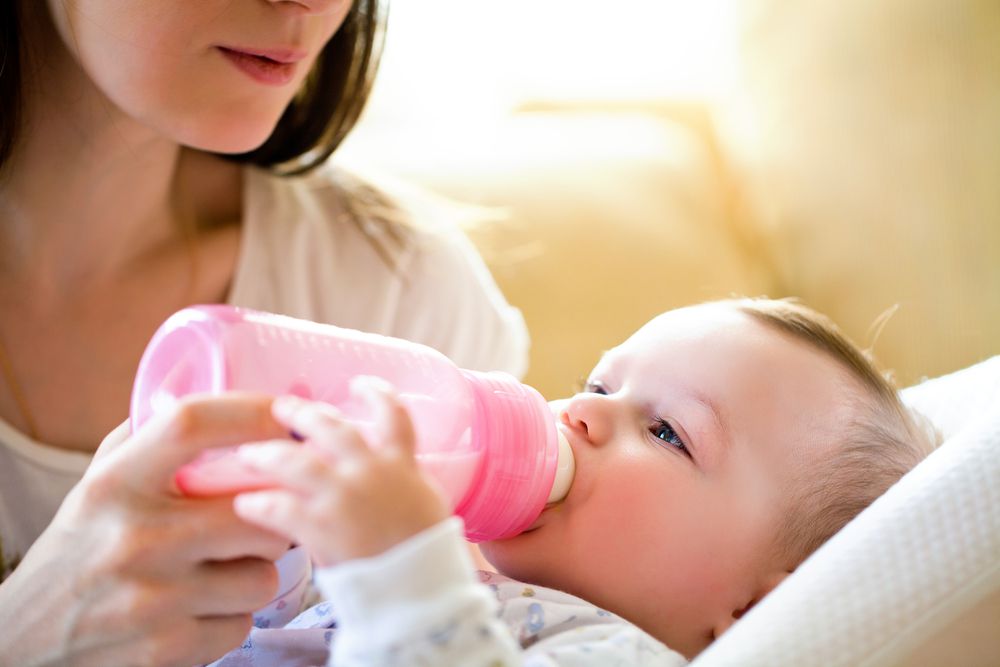If you’re preparing to go back to work after baby or planning a night out with your partner or with friends, you’ve probably started thinking about pumping, finding the right formula, and picking the best bottle for your baby.
Now it’s time to think about how to feed your baby with a bottle to fill your baby’s tiny tummy and reduce the risk of bottle refusal.
And after my research and experimentation with my own baby as well as supporting other families and their babies to bottle feed successfully, I highly recommend paced bottle feeding any time you give your baby a bottle.
Paced bottle feeding is a method of bottle feeding that mimics breastfeeding. Paced bottle feeding puts your baby in control of the feeding, increases your baby’s comfort during bottle feedings, and helps your baby to connect with the person offering the bottle and create a positive association with bottle feeding.

Paced bottle feeding helps to reduce gas, colic symptoms, and bottle refusal. Because it’s so beneficial, I actually recommend using this method of bottle feeding for all babies.
Since it’s so helpful, I put together a few tips to help you understand exactly what paced bottle feeding is and how you can get started during your baby’s next bottle session.
Jump To:
🍼 Traditional bottle feeding ⏱️ What is paced bottle feeding? 🏁 Get started with paced bottle feeding ⌛ How long should paced bottle feeding take? 👍 What are the benefits of paced bottle feeding? 🤱 Reduce Nipple Confusion 💨 Will paced bottle feeding cause gas problems? 🍼 What are the best bottles for paced bottle feeding? 💭 Final Thoughts
DISCLOSURE: Piece of Cake Parenting is a participant in the Amazon Services LLC Associates Program, an affiliate advertising program. As an Amazon Associate, I earn from qualifying purchases. Read more about these links in my disclaimer policy.
Traditional Bottle Feeding
Back in the day, the traditional bottle feeding method was to lay your baby down in your lap, pop a bottle in their mouth, and hold the bottle almost vertically during their bottle feeding.
But over time, we’ve learned that traditional bottle feeding usually leads to overeating, stomach discomfort, and even increases the risk of bottle refusal.
That’s because traditional bottle feeding puts all of the control on the parents while baby just tries to keep up and scarf down the milk as fast as it’s given to them.
What is Paced Bottle Feeding?
Paced feeding is a style of bottle feeding your baby that prioritizes mimicking breastfeeding, putting your baby in control of the feeding, and reducing the risk of bottle preference or bottle refusal.
With paced bottle feeding, you pace the feeding to allow your baby to control how quickly or how slowly they eat. Paced bottle feeding empowers your baby to listen to their body so they can pause when they need a break and stop eating when they're full rather than when their bottle is empty.
With paced bottle feeding, your baby not only controls the speed of the feeding, they also work harder to get milk, just like they would with breastfeeding, rather than passively taking in milk like they do with traditional bottle feeding.
Because they have more control, paced bottle feeding teaches your baby to stay in tune with their hunger and fullness signals, prevents feelings of discomfort or symptoms or overeating and eating too quickly, and reduces the risk of your baby preferring bottles because it’s easier or refusing bottles because it’s uncomfortable.

Get Started with Paced Bottle Feeding
Anytime your baby is taking a bottle, I recommend paced bottle feeding.
I actually support it so much that I even recommend doing a quick demo or showing this post to any family member, friend, or caregiver who offers your baby a bottle because it is well worth it for a happy baby who’s consistently getting all of the benefits of paced bottle feeding.
So how do you get started and what do you need to do to use paced bottle feeding with your baby?
1. Hold your baby in an upright position.
Although we naturally think to lay our babies down while bottle feeding, that’s the opposite of what we want to do. Instead, try to keep your baby sitting almost completely upright in just a slightly reclined position throughout the entire feeding.
This means gravity won’t get in the way of your paced bottle feeding efforts and feed your baby too quickly.
Instead, you can help your baby to slow down and take control of the feeding.
2. Let your baby actively take in the nipple.
Breastfeeding naturally stimulates your baby’s root and suck reflexes, but these are often understimulated in bottle fed babies. Luckily, paced bottle feeding helps to stimulate these important reflexes.
Instead of forcing the bottle into your baby’s mouth at the beginning of a feeding, let your baby do the work to take in the bottle nipple by following these steps:
1. Lightly brush the nipple against your baby's lips from top to bottom. 2. Then allow your baby to search for the nipple and open their mouth wide. 3. Once your baby has opened wide, this is your cue to insert the bottle nipple into your baby's mouth.
Repeat this process at the beginning of every feeding as well each time your baby takes a break from their bottle feeding and then wants to re-latch.
⭐ Pro-Tip: Actively letting your baby take in the nipple while bottle feeding also helps breastfeeding parents because it promotes better habits and a better latch while breastfeeding.
3. Hold the bottle horizontally.
This step is the key to successful paced bottle feeding.
When you give your baby their bottle, keep it parallel to the floor, or as close to parallel as you can.
Instead of holding the bottle upside down and completely filling the nipple with milk, try to keep it as flat as you can and just tip it until there’s a little milk in the nipple.
When you hold your baby’s bottle horizontally instead of vertically, you slow down the milk flow dramatically and keep your baby from eating too much too fast.
This also stimulates the slower flow of breastfeeding and prevents your baby from preferring the bottle over the breast.

4. Use the slowest nipple flow that you can.
Remember, the whole point of paced bottle feeding is to slow down the bottle feeding and give your baby more control.
Which means that you want to use the slowest nipple flow that you can.
Stick with newborn or slow nipple flow even as your baby gets older unless you have a fast let-down while breastfeeding or your baby is showing signs of bottle refusal, frustration, or exhaustion from the slow flow.
5. Pause throughout the feeding.
When your baby is breastfeeding, they’ll naturally suck for a few minutes and then pause. When they pause, the milk stops flowing and they can rest as long or short as they want to before continuing their feeding.
With bottle feeding, the milk will continue to trickle out even if your baby isn’t actively sucking.
So watch your baby’s cues and pause and restart your feeding throughout the feeding.
This helps to mimic the natural pauses and breaks your baby takes and the natural let-down reflex of breastfeeding. It also gives your baby time to tune into their body and decide if they’re full or want to continue drinking.
During these pauses, tip the bottle down so the milk isn’t flowing into the nipple or remove the nipple for a short break and then allow your baby to root for the nipple and begin eating again while they stay in control of the bottle session.
6. Switch sides halfway.
This is an important step of paced bottle feeding that is often missed. (I’ll admit, I didn’t even think about this AT ALL until I found it during my research and my baby was a few months old. We’d done every single bottle session on the same side up to that point. 😬)
Halfway through your bottle session, burp your baby and then switch arms and hold your baby on the opposite side.
Switching sides prevents side preference, reduces the risk of torticollis, and ensures that all facial muscles are evenly developed because your baby sees your face and the bottle from both angles equally.
Switching sides is also important to prevent your baby from getting a flat spot on one side of their head, which can happen if you’re always cradling your baby on the same side and putting pressure on just one side of your head.
7. Stop bottle feeding when your baby shows signs of fullness.
I know how tempting it is to nudge your baby to drink a little more or encourage them to finish the whole bottle so your breastmilk or formula doesn’t go to waste. And most of the time, your baby will keep drinking if you keep offering the bottle, even if they’re already full.
However, pushing your baby to continue drinking their bottle after they’re full leads to overeating, ignoring their instincts, extra gassiness, spitting up, and colic symptoms.
Watch your baby closely for signs of fullness.
When your baby starts refusing the nipple, turning their face away, playing or biting at the nipple, or dozing off and letting the nipple fall out of their mouth, it’s usually a sign that they’re full.
When you see these signs, take a break for a few seconds and then gently touch the nipple on your baby’s cheek or lips to see if they want to re-latch and continue the feeding.
If not, respect your baby’s signals and stop the feeding even if there’s only a little bit of milk left and you’re really tempted to help them finish it off.
How Long Should Paced Bottle Feeding Take?
As you (and anyone else giving your baby a bottle) make the shift to paced bottle feeding, I encourage you to think about bottle feeding differently.
Instead of quickly giving your baby a bottle and then moving on with your day, think of this as a chance to slow down, tune into your little one, and connect and bond with each other.
Then remember, we don’t want bottle sessions to be done in a couple of minutes. We want to mimic nursing and give your baby control to eat as comfortably as possible.
This means that most paced bottle sessions typically last 10-20 minutes.

If your baby is regularly eating much faster than this, consider switching to a slower flow or reviewing the steps of paced bottle feeding to slow things down a bit, especially if you’re seeing signs that your baby is uncomfortable after eating.
If your baby is regularly eating much slower than this, consider meeting with a lactation consultant or pediatric dentist to look for signs of a tongue or lip tie, especially if your baby is sleeping with their mouth open, snoring, making clicking noises, or you have painful latches while breastfeeding.
What are the Benefits of Paced Bottle Feeding?
We’ve talked about the steps to start paced bottle feeding, but I wanted to go over the benefits in case you’re still on the fence or you’re asking family, friends, or other caregivers to use paced bottle feeding and they’re hesitant to make the shift from traditional bottle feeding.
1. Longer and more successful breastfeeding
Paced bottle feeding mimics breastfeeding and decreases the odds that your baby will go on a nursing strike or prefer the bottle since it’s easier than nursing.
Trust me, proactively preventing these challenges will save you so many struggles and frustrations and help you to meet your breastfeeding goals.
Make sure that you educate everyone that will give your baby a bottle about how to do these feedings correctly and aim to have every bottle session from here on out with paced feeding.
2. Support your pumping goals
Since paced bottle feeding follows your baby’s hunger cues, you feed your baby when they’re hungry and stop when they’re full.
This prevents your baby from being overfed or underfed, which is invaluable to you if you’re nursing.
Because your baby isn’t overfed while taking bottles, you can keep up with the demand and don’t need to worry about not pumping enough to feed your baby while you’re away.
3. Decreases colic symptoms
Many baby’s show symptoms of colic or extra fussiness during certain times of day, especially during the first few months. And we’re learning that many of these symptoms can be caused by overfeeding or eating too quickly.
Paced bottle feeding prevents that uncomfortable stomach distension, which also decreases colic symptoms.
4. Reduces baby gas
Along those same lines, many babies struggle a lot with baby gas during the first few months.
Gas builds up easily and your baby’s digestive system is too immature to know how to get rid of it.
Paced bottle feeding sends the milk directly to the base of your baby’s stomach and keeps the air on top. This means air doesn’t get trapped in the digestive tract.
Instead your baby is able to burp it out, which is much easier and much more comfortable to burp out right away then break up gas bubbles once they’ve settled in your baby’s digestive tract.
5. Prevents earaches and ear infections
Many people believe that bottle fed babies are more susceptible to ear aches and ear infections.
However, these occur because eating while fully reclined puts much more pressure on your baby’s ears.
Using paced bottle feeding relieves this pressure and allows milk to go straight to the digestive tract.
6. Decreases spitting up
It’s also believed that bottle fed babies spit up more than breastfed babies. But this only occurs because bottle fed babies often eat too fast and too much.
Because baby tummies don’t want to distend and expand to take in more milk than they’re meant for, they’re more likely to spit up all of that extra milk.
By using paced bottle feeding and listening to your babies cues, you stop when they’re full and can greatly decrease the amount of spit up.
7. More bonding with your baby
Oftentimes the non-breastfeeding parent feels like they can’t bond with their baby as much as their breastfeeding partner.
Likewise, many parents mourn heavily if breastfeeding doesn’t work the way they envisioned.
Paced bottle-feeding allows moms, dads, grandparents, and anyone else to bond with your baby every time they eat because you’re respecting them and following their lead.

Because you’re focusing on their comfort and their control, you also create bottle feeding sessions that promote deep bonding between you and your baby and help your to think of bottle sessions as a highlight of the day and special time for them to bond with their loved ones.
Reduce Nipple Confusion
Most new parents are really worried about nipple confusion when introducing a bottle. But nipple confusion isn’t actually the problem. It’s nipple flow confusion.
When babies are given a bottle before fully establishing their breastfeeding relationship (and sometimes even after this has been established), they may prefer the easier bottle sessions and faster nipple flow to working hard to get milk while nursing.
This is one reason why paced bottle feeding is so beneficial. During paced bottle feeding, you focus on mimicking breastfeeding as much as you can so your baby never develops this nipple flow confusion.
Which means paced bottle feeding allows you to switch back and forth between breast and bottle whenever you need to much more easily.
Will Paced Bottle Feeding Cause Gas Problems?
This is actually a really common question.
Because you’re not completely filling the bottle nipple throughout the entire feeding, you might worry that your baby will suck in more air and have more gas issues.
But remember, you’re slowing down the feed so your baby will take in less air than traditional feeding.
You’re also keeping your baby reclined so the milk settles down, the air stays on top, and you can easily burp out any extra air, which decreases overall gas issues since these bubbles aren’t getting stuck throughout your baby’s entire digestive tract.
If you’re noticing gas problems, you can switch to a breast-shaped nipple bottle or bottle designed to reduce air intake and make sure that you’re using the slowest nipple flow available for your bottle.
What are the Best Bottles for Paced Bottle Feeding?
Any bottle can work for paced bottle feeding since it’s more about how you offer the bottle than what type of bottle you use.
However, here are a few of our favorite bottles that are great for paced bottle feeding with your baby.
Comotomo Natural-Feel Baby Bottle
The Comotomo bottle is specifically designed to closely mimic breastfeeding and reduce bottle rejection and nipple confusion and moms in our community love it.
It comes with a dual anti-colic vent to reduce the amount or air that your baby drinks and prevent gas challenges and colic symptoms.
It also has a wide opening that makes it super easy to clean afterward and is microwave and dishwasher safe.
Playtex Baby Ventaire Bottle
The Playtex Ventaire bottle is designed with a unique anti-colic design that supports paced bottle feeding.
Their angle design supports semi-upright feeding and the silicone rings and vented base helps to keep air at the back of the bottle to prevent your baby from drinking air during bottle feedings.
This one happens to be my favorite because it’s what we used with our baby. 😊 It’s also dishwasher safe which helps with easy clean up.
Tommee Tippee Anti-Colic Bottle
The Tommee Tippee bottle is another favorite for parents in our community. It’s unique anti-colic straw pulls air away from the milk to reduce symptoms of colic, gas, spit up, and discomfort for your baby.
The anti-colic straw also has a unique heat sensing technology that turns pink when your milk is too hot and the wide neck design promotes a good latch during feedings.
Final Thoughts
Using paced bottle feeding is a great way to mimic breastfeeding and give your baby more control to listen to their body during feedings.
Paced bottle feeding reduces overeating, gas problems, colic symptoms, spitting up, bottle refusal, bottle preference, and helps you to bond with your baby while bottle feeding.
Try to slow down your bottle feedings and tune into your baby’s needs while drinking to get the most out of paced bottle feeding.



